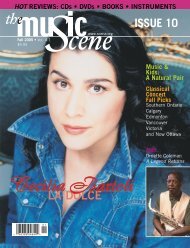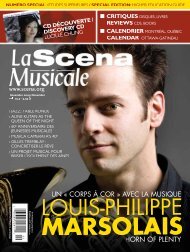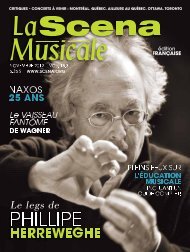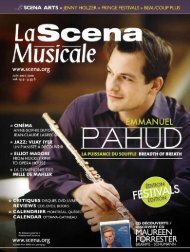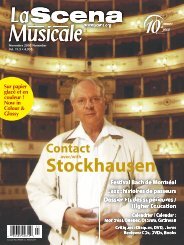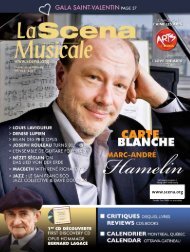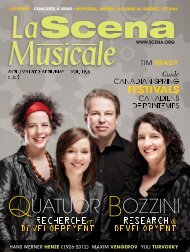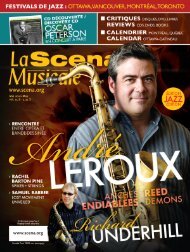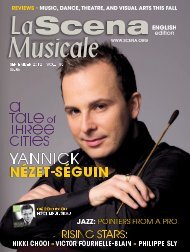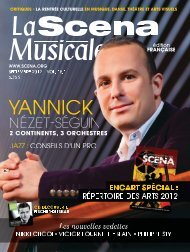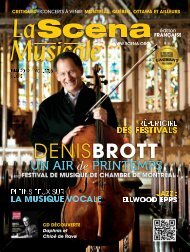Create successful ePaper yourself
Turn your PDF publications into a flip-book with our unique Google optimized e-Paper software.
75 th BIRTHDAY REICH<br />
by LUCIE RENAUD<br />
<strong>La</strong> Monte Young started it, Terry Riley (with his In C) provided<br />
the foundation, and Philip Glass reclaimed it, but<br />
many consider Steve Reich the most important figure in<br />
American minimalism.<br />
“My generation is not a revolution. It was a restoration! A restoration<br />
of normalcy where popular sources were brought back into the normal<br />
situation of classical forces, and classical music—music that I was<br />
writing, that Glass or Terry Riley was<br />
writing—was interesting to the pop<br />
musicians,” explained Steve Reich,<br />
his legendary baseball cap in place,<br />
at the outset of an interview given for<br />
the Domaine Privé concert, held to<br />
mark his 75 th birthday, at the Cité de<br />
la Musique de Paris, October 11 to 18.<br />
Born October 3, 1936, in New York,<br />
Steve Reich initially studied piano<br />
before turning to percussion after<br />
hearing Kenny Clarke, the drummer<br />
for Miles Davis. He studied philosophy<br />
at Cornell and deepened his understanding<br />
of music history before<br />
devoting himself to composition<br />
with jazzman Hall Overton, William<br />
Bergsma, and Vincent Persichetti at the Juilliard School, where he was<br />
a contemporary of Philip Glass. He found himself in California next,<br />
and worked with Darius Milhaud and Luciano Berio. He rejected serialism,<br />
but stayed close to the modal jazz of John Coltrane and discovered<br />
African rhythms and percussion, which would<br />
repetition without redundancy<br />
THE ESSENTIAL STEVE REICH<br />
It’s Gonna Rain (1965)<br />
was designed around a repetitive<br />
motif and tape loops and essentially<br />
plays on the contrast between<br />
the human voice and<br />
electronic sounds.<br />
Music for 18 Musicians (1976)<br />
is based on eleven fundamental<br />
chords that serve as pillars for the<br />
entire work. During the creation of<br />
this piece, Reich studied the Balinese<br />
gamelan.<br />
Different Trains (1988)<br />
superimposes the voices of Pullman<br />
train conductors over those of<br />
Shoah survivors accompanied by a<br />
string quartet: the American Dream<br />
mingled with the horror of war.<br />
become the essence of the rhythmic<br />
cells in his writing. Swept up<br />
in the psychedelic wave, rock, he<br />
adopted an approach not devoid of<br />
tonal references.<br />
When he reflects on his years of<br />
study, Reich recalls the days when<br />
it was necessary for a young composer<br />
to master serial writing in<br />
order to be taken seriously by<br />
one’s peers. “I would say that I<br />
have a great deal more respect and<br />
regard for Webern than I do for<br />
Schoenberg because Schoenberg<br />
didn’t understand that he was<br />
writing contrapuntal music; he<br />
thought he was writing romantic<br />
music with twelve-tone notes. Webern<br />
understood that this was a<br />
contrapuntal technique. That political<br />
power, that you must write this way, was very powerful in the academic<br />
world and throughout the musical world. I say that my generation<br />
brought that to an end.”<br />
Steve Reich has achieved this tabula rasa especially by prioritizing the<br />
use of repetition, a strategy that allows him to create “music as a gradual<br />
process.” In a 1968 text, he clarified his approach: “The distinctive<br />
thing about musical processes is that they determine all the note-tonote<br />
(sound-to-sound) details and the over all form simultaneously.<br />
(Think of a round or infinite canon.) I am interested in the perceptible<br />
processes. I want to be able to hear<br />
the processes happening throughout<br />
the sounding music. To facilitate<br />
closely detailed listening a musical<br />
process should happen extremely<br />
gradually.”<br />
Unlike Cage, who uses random<br />
processes to influence the course of<br />
the narrative, Reich opts for a more<br />
collective search, a liberating ritual<br />
that permits multiple combinations<br />
of musical phrases from which he<br />
extracts the final material.<br />
“What I’m interested in is a compositional<br />
process and a sounding<br />
music that are one and the same<br />
thing. … The use of hidden structural<br />
devices in music never appealed to me. Even when all the cards<br />
are on the table and everyone hears what is gradually happening in a<br />
musical process, there are still enough mysteries to satisfy all,” he said.<br />
“These mysteries are the impersonal, unintended, psycho-acoustic byproducts<br />
of the intended process. These might include<br />
City Life (1995) was built around<br />
the sounds of New York City and<br />
remains one of the composer’s<br />
best-known works.<br />
Double Sextet (2007) won a<br />
Pulitzer Prize. Written for two identical<br />
sextets with interlacing motives.<br />
Reich considers this work<br />
among his most complete.<br />
WTC 9/11 (2011) has already<br />
been the source of much controversy,<br />
largely due to the original<br />
album artwork depicting the Twin<br />
Towers, which has since been<br />
changed. Written for three string<br />
quartets (one live, two recorded)<br />
and recorded voices, it is meant to<br />
be more dissonant.<br />
sub-melodies heard within repeated<br />
melodic patterns, stereophonic<br />
effects due to listener<br />
location, slight irregularities in performance,<br />
harmonics, difference<br />
tones, etc.”<br />
Over the years, his musical language<br />
has evolved, but he favors<br />
small ensembles. If he composes<br />
little today, his works are played<br />
the world over, interesting even to<br />
electronica DJs.<br />
LSM<br />
Steve Reich’s 2x5 will be performed at<br />
Acadia University in Wolfville, Nova Scotia<br />
on Feb. 4, 2011. Further performances of<br />
his work may be announced in the upcoming<br />
year.<br />
TRANSLATION:<br />
REBECCA ANNE CLARK<br />
DECEMBER 2011 / JANUARY 2012<br />
17



